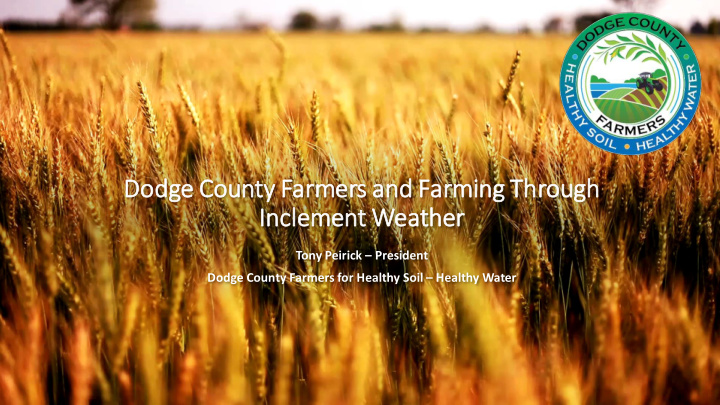



Do Dodge Cou ounty ty Farmers and nd Far arming Thr hrou ough Inc ncle lement Weather Tony Peirick – President Dodge County Farmers for Healthy Soil – Healthy Water
Recent Weather Trends • Wet and rainy weather have proved to be troublesome for farms. • Worse off are the farmers who do not use soil health practices • Farmers who use soil health practices were able to plant their fields earlier, harvest earlier and rutted their fields less • Reduced compaction • Maintained good soil structure
Courtesy of: Rob Davis – DNR Water Management Engineer April 15, 2019
Courtesy of: Rob Davis – DNR Water Management Engineer April 15, 2019
How can Producers Farm Around Inclement Weather?
Soil Health • “The continued capacity of a soil to function as a vital, living ecosystem that sustains plants, animals, and humans.”
No-Till • Reduced/No-Till systems keep that carbon in the soil • Tillage can release carbon into the atmosphere where no-till sinks it. • Soil is one of the greatest carbon sinks available to us. • Forms of Minimum Tillage • Strip-Till • Ridge-Till • Zone-Till
Cover Crops • Legume cover crops can sequester carbon from the atmosphere • Other cover crops provide other benefits such as: • Reduced runoff • Reduced erosion • Weed Suppression • Improved soil structure • Increased Nitrogen Fixing • Building of Organic Matter • Improved microbial activity • Increased porosity/infiltration
Cover Cropping Fall Seeding Cereal Rye Planting Multi-Species Cover Crops after wheat or silage Frost Seeding Interseeding Interseeding 60” rows Planting Green Grazing
Nutrient Sequestration Cereal Rye Rye Height N P2O5 0-46-0 K20 0-0-60 Sulfur Mg Ca Biomass 12” Rye 82 15 32 76 133 5 4 11 2000 18” Rye 120 20 44 128 213 6 6 18 4000 28” Rye 134 30 64 169 281 10 12 31 6000 Dead Rye 84 29 64 39 65 3 11 29 3500 Note: Dead rye sample was taken 2 months after termination
Cover Cropping Fall Seeding Cereal Rye Planting Multi-Species Cover Crops after wheat or silage Frost Seeding Interseeding Interseeding 60” rows Planting Green Grazing
Cover Cropping Fall Seeding Cereal Rye Planting Multi-Species Cover Crops after wheat or silage Frost Seeding Interseeding Interseeding 60” rows Planting Green Grazing
Cover Cropping Fall Seeding Cereal Rye Planting Multi-Species Cover Crops after wheat or silage Frost Seeding Interseeding Interseeding 60” rows Planting Green Grazing
Cover Cropping Fall Seeding Cereal Rye Planting Multi-Species Cover Crops after wheat or silage Frost Seeding Interseeding Interseeding 60” rows Planting Green Grazing
Cover Cropping Fall Seeding Cereal Rye Planting Multi-Species Cover Crops after wheat or silage Frost Seeding Interseeding Interseeding 60” rows Planting Green Grazing
Cover Cropping Fall Seeding Cereal Rye Planting Multi-Species Cover Crops after wheat or silage Frost Seeding Interseeding Interseeding 60” rows Planting Green Grazing
In-Field Determination of Soil Health
Soil Structure • Friable • Aggregates present • Cottage cheese/chocolate cake look • Porous • Microbial activity • Undisturbed root systems • Gas exchange • Water movement
Soil Biology • Worms and other life are present • Presence of life • Castings • Worm channels • Movement of residue under soil surface
Nutrient Efficiency • In-Field Nitrogen Use Efficiency • Strips in field with only starter applied • UW-Discovery Farms program can help put numbers to the analysis • Basic field calculations
Water Infiltration • Mimicking a rainfall event • Determines how fast a soil can take in water • Soil type and tillage are factors to determine this • Simple in-field experiment
• Implementation of soil health practices can help to reduce runoff and erosion numbers as well as create a more efficient carbon sink all while making agriculture more sustainable. Tak akeaways • The best way to get farmers to implement these practices is by education • Breakdown the excuses as to why no-till and cover crops won’t work for farmers. • Showcase examples of practices working in their areas • Show what benefits a farmer can gain from using these practices • Provide incentives for farmers using conservation/soil health practices
Thank you from the Dodge County Farmers for Healthy Soil – Healthy Water Tony Peirick – President Phone #: (920) 390-0583 Email: tspeirick@hughes.net Board Members Marty Weiss – Vice President Dave Roche – Treasurer Brendon Blank – Secretary Jeff Gaska Troy Christenson Mission: “Improving our community’s soil & water Members At-Large through conservation practices & Dale Macheel education” Bill Stangel
Recommend
More recommend